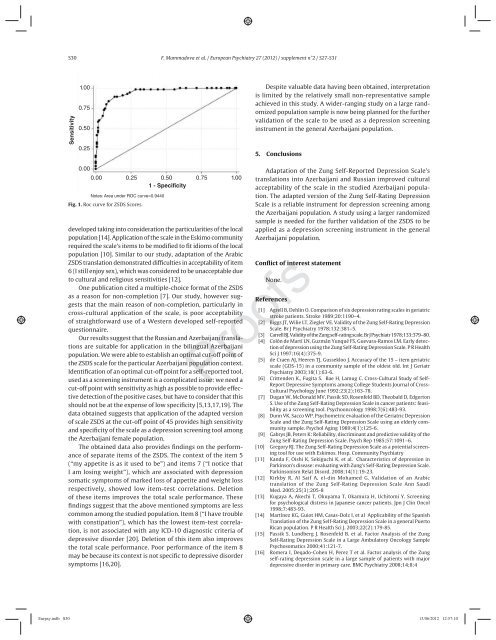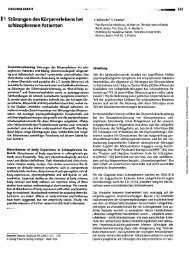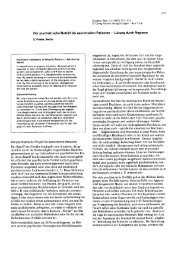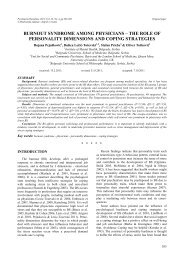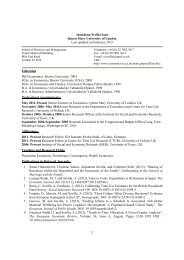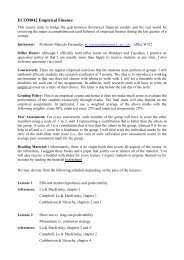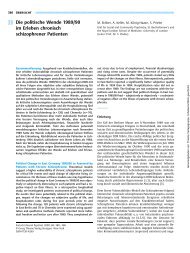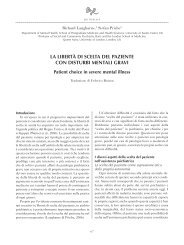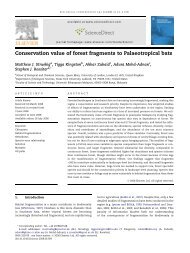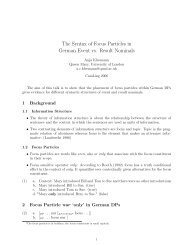Proofs - Personal Webspace for QMUL - Queen Mary, University of ...
Proofs - Personal Webspace for QMUL - Queen Mary, University of ...
Proofs - Personal Webspace for QMUL - Queen Mary, University of ...
You also want an ePaper? Increase the reach of your titles
YUMPU automatically turns print PDFs into web optimized ePapers that Google loves.
S30 F. Mammadova et al. / European Psychiatry 27 (2012) / supplement n°2 / S27-S31<br />
Sensitivity<br />
1.00<br />
0.75<br />
0.50<br />
0.25<br />
0.00<br />
0.00<br />
0.25<br />
Notes: Area under ROC curve=0.9440<br />
Fig. 1. Roc curve <strong>for</strong> ZSDS Scores.<br />
0.50<br />
1 - Specificity<br />
0.75<br />
1.00<br />
developed taking into consideration the particularities <strong>of</strong> the local<br />
population [14]. Application <strong>of</strong> the scale in the Eskimo community<br />
required the scale’s items to be modifi ed to fi t idioms <strong>of</strong> the local<br />
population [10]. Similar to our study, adaptation <strong>of</strong> the Arabic<br />
ZSDS translation demonstrated diffi culties in acceptability <strong>of</strong> item<br />
6 (I still enjoy sex), which was considered to be unacceptable due<br />
to cultural and religious sensitivities [12].<br />
One publication cited a multiple- choice <strong>for</strong>mat <strong>of</strong> the ZSDS<br />
as a reason <strong>for</strong> non- completion [7]. Our study, however suggests<br />
that the main reason <strong>of</strong> non- completion, particularly in<br />
cross- cultural application <strong>of</strong> the scale, is poor acceptability<br />
<strong>of</strong> straight<strong>for</strong>ward use <strong>of</strong> a Western developed self- reported<br />
questionnaire.<br />
Our results suggest that the Russian and Azerbaijani translations<br />
are suitable <strong>for</strong> application in the bilingual Azerbaijani<br />
population. We were able to establish an optimal cut- <strong>of</strong>f point <strong>of</strong><br />
the ZSDS scale <strong>for</strong> the particular Azerbaijani population context.<br />
Identifi cation <strong>of</strong> an optimal cut- <strong>of</strong>f point <strong>for</strong> a self- reported tool,<br />
used as a screening instrument is a complicated issue: we need a<br />
cut- <strong>of</strong>f point with sensitivity as high as possible to provide effective<br />
detection <strong>of</strong> the positive cases, but have to consider that this<br />
should not be at the expense <strong>of</strong> low specifi city [5,13,17,19]. The<br />
data obtained suggests that application <strong>of</strong> the adapted version<br />
<strong>of</strong> scale ZSDS at the cut- <strong>of</strong>f point <strong>of</strong> 45 provides high sensitivity<br />
and specifi city <strong>of</strong> the scale as a depression screening tool among<br />
the Azerbaijani female population.<br />
The obtained data also provides fi ndings on the per<strong>for</strong>mance<br />
<strong>of</strong> separate items <strong>of</strong> the ZSDS. The context <strong>of</strong> the item 5<br />
(“my appetite is as it used to be”) and items 7 (“I notice that<br />
I am losing weight”), which are associated with depression<br />
somatic symptoms <strong>of</strong> marked loss <strong>of</strong> appetite and weight loss<br />
respectively, showed low item- test correlations. Deletion<br />
<strong>of</strong> these items improves the total scale per<strong>for</strong>mance. These<br />
fi ndings suggest that the above mentioned symptoms are less<br />
common among the studied population. Item 8 (“I have trouble<br />
with constipation”), which has the lowest item- test correlation,<br />
is not associated with any ICD- 10 diagnostic criteria <strong>of</strong><br />
depressive disorder [20]. Deletion <strong>of</strong> this item also improves<br />
the total scale per<strong>for</strong>mance. Poor per<strong>for</strong>mance <strong>of</strong> the item 8<br />
may be because its context is not specifi c to depressive disorder<br />
symptoms [16,20].<br />
Despite valuable data having been obtained, interpretation<br />
is limited by the relatively small non- representative sample<br />
achieved in this study. A wider- ranging study on a large randomized<br />
population sample is now being planned <strong>for</strong> the further<br />
validation <strong>of</strong> the scale to be used as a depression screening<br />
instrument in the general Azerbaijani population.<br />
5. Conclusions<br />
Adaptation <strong>of</strong> the Zung Self- Reported Depression Scale’s<br />
translations into Azerbaijani and Russian improved cultural<br />
acceptability <strong>of</strong> the scale in the studied Azerbaijani population.<br />
The adapted version <strong>of</strong> the Zung Self- Rating Depression<br />
Scale is a reliable instrument <strong>for</strong> depression screening among<br />
the Azerbaijani population. A study using a larger randomized<br />
sample is needed <strong>for</strong> the further validation <strong>of</strong> the ZSDS to be<br />
applied as a depression screening instrument in the general<br />
Azerbaijani population.<br />
Confl ict <strong>of</strong> interest statement<br />
None.<br />
References<br />
[1] Agrell B, Dehlin O. Comparison <strong>of</strong> six depression rating scales in geriatric<br />
stroke patients. Stroke 1989;20:1190–4.<br />
[2] Biggs JT, Wilie LT, Ziegler VE. Validity <strong>of</strong> the Zung Self- Rating Depression<br />
Scale. Br J Psychiatry 1978;132:381–5.<br />
[3] Carrell BJ. Validity <strong>of</strong> the Zung self- rating scale. Br J Psychiatr 1978;133:379–80.<br />
[4] Colón de Martí LN, Guzmán Yunqué FS, Guevara- Ramos LM. Early detection<br />
<strong>of</strong> depression using the Zung Self- Rating Depression Scale. P R Health<br />
Sci J 1997;16(4):375- 9.<br />
[5] de Craen AJ, Heeren TJ, Gussekloo J. Accuracy <strong>of</strong> the 15 – item geriatric<br />
scale (GDS- 15) in a community sample <strong>of</strong> the oldest old. Int J Geriatr<br />
Psychiatry 2003;18(1):63- 6.<br />
[6] Crittenden K., Fugita S. Bae H, Lamug C. Cross- Cultural Study <strong>of</strong> Self-<br />
Report Depressive Symptoms among College Students Journal <strong>of</strong> Cross-<br />
Cultural Psychology June 1992:23(2):163- 78.<br />
[7] Dugan W, McDonald MV, Passik SD, Rosenfeld BD, Theobald D, Edgerton<br />
S. Use <strong>of</strong> the Zung Self- Rating Depression Scale in cancer patients: feasibility<br />
as a screening tool. Psychooncology 1998;7(6):483- 93.<br />
[8] Dunn VK, Sacco WP. Psychometric evaluation <strong>of</strong> the Geriatric Depression<br />
Scale and the Zung Self- Rating Depression Scale using an elderly community<br />
sample. Psychol Aging 1989;4(1):125- 6.<br />
[9] Gabrys JB, Peters K: Reliability, discriminant and predictive validity <strong>of</strong> the<br />
Zung Self- Rating Depression Scale. Psych Rep 1985;57:1091–6.<br />
[10] Gregory RJ. The Zung Self- Rating Depression Scale as a potential screening<br />
tool <strong>for</strong> use with Eskimos. Hosp. Community Psychiatry<br />
[11] Kanda F, Oishi K, Sekiguchi K, et al. Characteristics <strong>of</strong> depression in<br />
Parkinson’s disease: evaluating with Zung’s Self- Rating Depression Scale.<br />
Parkinsonism Relat Disord. 2008;14(1):19- 23.<br />
[12] Kirkby R, Al Saif A, el- din Mohamed G. Validation <strong>of</strong> an Arabic<br />
translation <strong>of</strong> the Zung Self- Rating Depression Scale Ann Saudi<br />
Med. 2005;25(3):205- 8<br />
[13] Kugaya A, Akechi T, Okuyama T, Okamura H, Uchitomi Y. Screening<br />
<strong>for</strong> psychological distress in Japanese cancer patients. Jpn J Clin Oncol<br />
1998;7:483- 93.<br />
[14] Martínez KG, Guiot HM, Casas- Dolz I, et al Applicability <strong>of</strong> the Spanish<br />
Translation <strong>of</strong> the Zung Self- Rating Depression Scale in a general Puerto<br />
Rican population. P R Health Sci J. 2003;22(2):179- 85.<br />
[15] Passik S. Lundberg J. Rosenfeld B. et al. Factor Analysis <strong>of</strong> the Zung<br />
Self- Rating Depression Scale in a Large Ambulatory Oncology Sample<br />
Psychosomatics 2000;41:121- 7.<br />
[16] Romera I, Deqado- Cohen H, Perez T et al. Factor analysis <strong>of</strong> the Zung<br />
self- rating depression scale in a large sample <strong>of</strong> patients with major<br />
depressive disorder in primary care. BMC Psychiatry 2008;14;8:4<br />
<strong>Pro<strong>of</strong>s</strong>


